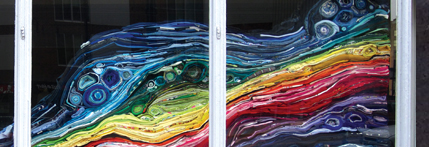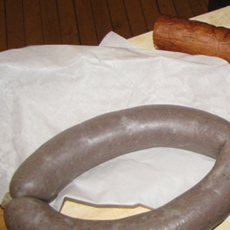From Japan’s tsunami to pop-art inspired history paintings, April’s on-campus lecture scene featured a dynamic group of speakers. Talking to students about everything from their practice to broader issues in art criticism, here’s a look at some of the lectures that were delivered this past month.
By Tara Plath, Staff Writer
Illustrations by Elliott Beazley & Easle Seo
Wangechi Mutu ends VAP on a High Note
 The last lecture in this year’s Visiting Artists Program had an enormous turnout on Tuesday, April 12. Every seat of the Columbus Auditorium was occupied by students, faculty and the general public, all eager to hear the words of collage and video artist Wangechi Mutu. SAIC Dean of Faculty Lisa Wainwright opened the night with emphatic words about her encounter with Mutu’s work in a New York gallery, noting Mutu’s ability to “blend the real with the unreal remains uncanny, never failing to mesmerize and bewitch. And I was bewitched.”
The last lecture in this year’s Visiting Artists Program had an enormous turnout on Tuesday, April 12. Every seat of the Columbus Auditorium was occupied by students, faculty and the general public, all eager to hear the words of collage and video artist Wangechi Mutu. SAIC Dean of Faculty Lisa Wainwright opened the night with emphatic words about her encounter with Mutu’s work in a New York gallery, noting Mutu’s ability to “blend the real with the unreal remains uncanny, never failing to mesmerize and bewitch. And I was bewitched.”
“If I seem nervous, it’s because I am,” Mutu immediately confessed upon taking the stage. The lecture and presentation that followed showed Mutu’s collages, sculptures and videos, woven together with quotes from the people who inspired her most and some of the violent imagery she draws from in her work.
Throughout the evening, Mutu confronted the audience with images that were hard to swallow: mass graves filled with the bodies of Holocaust victims, African children missing hands, mothers protesting their children’s imprisonment by baring their skin to disarm soldiers. Mutu’s decision to show these photographs—as well as the duration of time she required the audience to sit with each image—seemed carefully calculated. Her own familiarity with the images and their history provided insight into the sometimes grotesque nature of her own work.
In her work, Mutu’s depictions of the female form are composed of clippings from fashion magazines, National Geographic, old anatomy books and iconic images of Africa, each investigating fictitious symbols created by the media. Lips and legs from fashion editorials, breasts and thighs from pornography, and brightly-colored African garments and masks are unabashedly layered in such a way that they develop their own unique fictions—alien characters emerge, complete in their form and attitudes, squatting on the page.
Mutu’s lecture seemed thoughtfully aimed at the art school audience, as she addressed material, process, and life after art school. Her decision to work in collage was “entirely practical,” she explained. A lack of space and lack of resources when living in New York City after completing her MFA at Yale led her to create small works from found materials as a way of “reinventing herself” without the safety and support of the institution. Her long list of inspirations was enlightening — Eartha Kitt, Grace Kelly, Trinh T. Minh-ha, Sun Ra, the scientific photos measuring the proportions of African faces, and the newsstand, which she described as “one of the best fecal samples, the DNA of our society.” Mutu’s presentation of her work was articulate, illuminating, and in the words of Wainwright, “grotesquely delicious.” Overall, a great way to end the Spring 2011 season of Visiting Artists Program.
Chicago artist and UIC Instructor Doug Ischar talks photography at a Parlor Room lecture
Doug Ischar stood before a small audience at SAIC on April 19 as part of the Photography Department’s Parlor Room visiting artist program. He has taught in the Photography Department at the University of Illinois at Chicago since 1990, and his first body of photographs was shown in its entirety at Golden Gallery in 2009. This group of photos depicts young gay men sprawled across the Rocks, seemingly comfortable and relaxed; but “we were in the midst of a nightmare — the historical AIDS epidemic,” Ischar reminded his audience.
It was clear that Ischar’s emotions are deeply embedded in his work, as both a photographer and as a gay man. Regarding his second body of photographs, taken at San Francisco bar The Eagle, Ischar described the scene for the audience: “It was a type of environment where I’d spent countless hours and met countless men.” Although the artist imbued his presentation with his own poetic narrative, Ischar quickly grounded his work with personal humor and sentiment, verbally captioning one photograph of a man with a piercing stare as “exactly the type of guy I was cruising and fucking at the time.”
Ischar also showed footage from several of his video installations, explaining each piece one by one before showing them consecutively. The works were difficult to absorb, but one piece in particular stood out: “Off Limits” was an X-ray fluoroscope of the inside of a locked box given to Ischar by a friend who had passed away. Inside the box the X-ray slowly and methodically revealed porno mags, titty clamps, and keys to the box—a series of images that were detached, yet voyeuristic.
The final works Ischar showed were videos completed in 2008 and 2010. The first, titled “brb,” was composed of an AOL conversation that read like subtitles across blurry footage taken from a moving car. The conversation between Ischar and another man was extremely intimate and almost uncomfortable to read in a public forum, with one man wishing to be with the other, to “lick your tears, suck your dick.” The video matched the conversation’s pace, ending painfully slowly with several good byes, “hugs,” a “smooch,” and semicolon winks.
Ischar was nearly unable to end the barrage of questions asked at the end of the night: “Keep it comic, c’mon!” he pleaded. He was as honest and straightforward as possible, but still perhaps a bit too deeply embedded in his work to go as far as the audience may have wanted.
Dexter Dalwood speaks about death and dystopia at VAP Lecture
Dexter Dalwood spoke about his work to SAIC students and faculty at a Painting and Drawing Visiting Artist lecture on April 5. In a casual lecture and slideshow of his own work, Dalwood displayed a body of paintings and collages spanning over 20 years. Painting professor Terry Myers introduced Dalwood’s paintings as having a “packed fullness” that “begs us to take the bait.”
Before diving into a discussion of his work, Dalwood shared that he played bass guitar for the 1970s punk rock band, The Cortinas. Curiously, this information led into his first slide, which was an iconic photograph of Andy Warhol in his Factory. Through his interest in punk and the Velvet Underground, Dalwood was led to Warhol, in whom he was admittedly less interested than he was in The Factory. This intriguing space around Warhol was the impetus for an ongoing body of work that explored spaces in which things did, or did not, happen. The continued exploration of the potential of space began when Dalwood was “vaguely depressed” and could only paint the corner of his room, as it was in his direct line of vision from where he laid in bed.
Over the next two decades, the spaces Dalwood portrayed evolved into fictive cluttered stages with titles such as “Sharon Tate’s House,” “Bill Gates’ Bedroom,” and even an early, abstracted — but easily recognizable — painting of the interior of the Starship Enterprise (the artist admitted he was once a “space-race-nerd-kid”). For the most part, his paintings omit figures. “Occasionally I put a figure in,” he explained. “I don’t like the idea of the figure working as the protagonist.”
Dalwood calls his pieces history paintings. His subjects are rooted in historical calamities while his style relates to, or directly copies, art from the same time period. His compositions integrate iconic figures from pop culture as well as specific references to paintings from the Old Masters. “Jimi Hendrix’s Last Basement” places the viewer at a high and awkward angle, looking down and across the room at a bed and Morris Louis-inspired carpet. “Brian Jones’ Swimming Pool” — an homage to the late Rolling Stones star who was found dead at the bottom his swimming pool — references a Clifford Still painting with a flat blue shape against the interior walls of the pool. The cultural references go on and on, with “Jackie Onassis” — a depiction of Jackie O’s yacht — as well as “Robert Mapplethorpe’s First Loft,” and “Kurt Cobain’s Green House.”
Dalwood’s more recent work only gets darker. He explained that he was interested in things such as the very moment when something shifts from “real events to descriptions within fiction,” how utopias turn into dystopias, or the second when Lenny stops talking about the life he and George will live and pulls the trigger of a gun in “Of Mice and Men.” “All painting is about death in a way,” said Dalwood. “You walk by the old masters and you think they’re dead, they’re dead, they’re dead, they’re all dead.”
In the course of an hour, dozens of murdered celebrities, modernist painters, and other influences were listed,not excluding Kanye West’s new album and the rapper’s “deep understanding of appropriation.” Dalwood unleashed a refreshing, humorous account of his process and interests, as well as his dislikes. “You’ve got to know what you hate. I think hating is something positive… I love painting, but I also hate all sorts of shit I see.”
But in the end, the artist didn’t hesitate to proffer a bit of hope. “You make what you want to see.”
Physics teacher Kathryn Schaffer attempts to cool students’ fears with presentation on the recent catastrophe at Japan’s Fukushima Nuclear Plant
More than two dozen students and faculty gathered on March 21 to learn more about the Fukushima Nuclear Plant, whose radiation emissions are causing a crisis in both Japan and around the world. Schaffer, a physics teacher at SAIC, hoped to quell people’s fears by giving them a better understanding of the scientific terminology in the media. Using a slide show that she admittedly reduced to the simplest form of a physics lesson, Schaffer explained exactly what radioactive material is: a “lump of stuff emitting particle radiation.” Schaffer seemed most interested in giving students the tools to understand that, while the situation in Japan is serious, the language and images used by the media could lead to sensationalized ideas of nuclear reactions.
Explaining just how radioactive material was released by the earthquake, Schaffer shared that after an 9.0 magnitude earthquake and tsunami devastated Japan’s northeast coast on March 11, four nuclear reactors lost power when they were flooded by the giant waves. The loss of power caused the reactors’ cooling systems to fail, which led to the overheating of the fuel rods in the core, as well as adjacent spent fuel pools. The reactors were flooded with seawater in a desperate attempt to cool the rods, which, if not cooled, would produce hydrogen and an incredibly dangerous explosive situation. Explosions have already blown off the outer shells of some of the reactors, but the primary concrete containers that hold the fuel rods have not been extensively damaged.
While recent reports of evidence of radioactive material in the United States have renewed fears that we might also be at risk for exposure, Schaffer effectively broke down images and information presented in the media, assuaging concerns and decoding scientific jargon. Referencing harrowing photographs that have gained popularity through Internet circulation — such as small children being scanned for radioactivity, or a quarantined daughter speaking to her mother through foggy glass — Schaffer explained that these people’s health is most likely not at risk. Despite the seeming severity of radiation exposure, slight contact with radioactivity can be easily addressed with a shower.
An hour was certainly not enough to cover the wealth of complicated material Schaffer had prepared, and unfortunately, she had to skip several slides of her presentation in order to cover the most pertinent material. A quick question and answer session revolved around students’ own interests in being able to accurately gauge their safety if such a catastrophe were to happen here in Illinois, the state with the most nuclear reactors in the U.S. While Schaffer debriefed attendees about varying levels of potential exposure and nuclear threat, it was a humbling experience to have so many individuals gathered in response to crisis — even if it was to debunk how the earthquake potentially threatens the U.S.











U of C stands for the University of Chicago. Doug Ischar teaches at the University of Illinois at Chicago, or UIC.